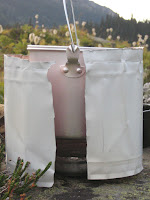I remember the first time I went into an outdoor store… not Army & Navy, but a real outdoor store. Well I remember the price and thinking that my dad would NEVER buy me anything like that. All that money for a stove and gear. Why? And then I remembered that my dad took us camping in old tents with with two small aluminum poles (from an age gone by) and a pack of matches.
When the Europeans came through and made a mess of things… they brought their “know how” and tinned food and heavy loads, but were faced to make two choices: Die, or listen to the locals. The locals and their know how influenced how the trappers and traders made their way across the continent (or didn’t) and even the things they sold had to drastically change when the native Americans stopped buying cheap rubbish and only traded for quality, usable kit.
 Now a dad and wanting to take my kids with me on trips, beit by car, boat or foot I’ve realized that I have to invest in local know how, skills and what I do learn from the “Europeans” needs to be quality, usable and light. Oh and cheap. I don’t live in Seattle and I have 5 mouths to feed.
Now a dad and wanting to take my kids with me on trips, beit by car, boat or foot I’ve realized that I have to invest in local know how, skills and what I do learn from the “Europeans” needs to be quality, usable and light. Oh and cheap. I don’t live in Seattle and I have 5 mouths to feed.
 The light aspect was learned on my first hiking trip with my daughter and wife. My daughter was a year old and we weren’t going to let that stop us. We ended up buying a Kelty Back Country Child Carrier (A deluxe version of the newer Kelty TC 3.0, which included the zip off day back and sun/rain hood) for my wife to carry. It was second hand and a great steal. It is a great pack that we still use, but there isn’t nearly as much space on the back country as their appears to be on the TC 3.0 for stuff, so that left me to carry
The light aspect was learned on my first hiking trip with my daughter and wife. My daughter was a year old and we weren’t going to let that stop us. We ended up buying a Kelty Back Country Child Carrier (A deluxe version of the newer Kelty TC 3.0, which included the zip off day back and sun/rain hood) for my wife to carry. It was second hand and a great steal. It is a great pack that we still use, but there isn’t nearly as much space on the back country as their appears to be on the TC 3.0 for stuff, so that left me to carry most of our supplies in and all the dirty diapers out (leave only footprints). That was when I realized, light and compact wasn’t an option it was a necessity.
most of our supplies in and all the dirty diapers out (leave only footprints). That was when I realized, light and compact wasn’t an option it was a necessity.
I didn’t have much of a backpack (one of the good old aluminum framed wonders from the 70s); space and money was a premium.That led me to look for cheap and light ways to pull off this 3 day expedition. That’s what led me to look into inexpensive alternatives to the $130+ backpacking stoves that shocked me years earlier (and their much more efficient modern counterparts). Using sites like Mark Jurey’s “Penny Ultralight Alcohol Stove” I put together something that was lighter and cheaper than what the outdoor store could offer me.
“Be careful, that looks dangerous” was the feedback from the doubters, and to be honest, one should be… careful, that is. With a bit of practice we never had a problem on the hikes we’ve used it on. In fact, that next day we turned around while our dinner was quietly simmering away to see 10 feet of flames coming from one of the $130+ backpacking stoves. I don’t think there is even enough fuel in the penny stove to get 10 feet of flames!
Since then I’ve puttered around with the DIY philosophy and until I get some kind of sponsorship, or a lot more money, I will continue the hunt for creative solutions for that balance of quality, lightweight and low-cost kit.
Video of how to make a variation on the Penny stove to come.
 The Outdoor Adventure Giving you tips, tricks & recommendations to help make adventuring in the Outdoors fun, safe & exciting for you and your kids.
The Outdoor Adventure Giving you tips, tricks & recommendations to help make adventuring in the Outdoors fun, safe & exciting for you and your kids.


